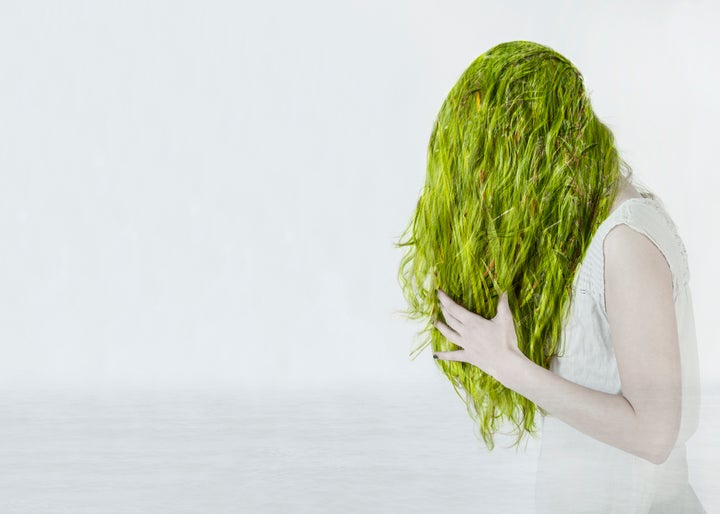
Those frequent trips to the pool may have filled your heart with fond summer vacation memories, but they likely also filled your hair with harsh chemicals that can cause major damage.
Chlorine can be an insidious hair killer, and the more time you spend in the pool, the more damage you’re likely to experience. That’s why we spoke to experts about how to protect your tresses before you take a dip, and the best ways to heal hair that’s already been overexposed to chlorine.
How chlorine affects your hair.
Dr. Isfahan Chambers-Harris, a trichologist who is well-versed in dealing with damaged hair, tells us that chlorine acts as a disinfectant, so it’s extremely harsh and can lead to dry, brittle hair and scalp irritation. “Chlorine also washes away sebum, the natural oils that our scalp produces, and sebum is overall protective for not only the scalp but the strands,” she said.
While all hair types and textures are prone to the drying effects of chlorine, hair that’s been colored, relaxed or otherwise chemically treated is particularly at risk.
“These types of chemical treatments make the hair more porous and they open the cuticle, which makes hair more susceptible to damage” said hairstylist Brittany Johnson. “Adding a strong chemical like chlorine on top of that is gonna have even more of an effect.”
Chambers-Harris warns that avid swimmers ― especially natural and bottle blonds ― might even see their hair change color, “because chlorine tends to oxidize copper, which leads to your hair having a greenish hue.” (FYI, our hair has small amounts of copper in it.)
If you think you’re safe because you’ve barely swum this year, think again. Just two visits to a pool in one week can lead to damaged hair.
Johnson has noticed it in clients immediately after a one-week vacation. “If you’re in chlorine consistently for days at a time without doing any extra protective measures to your hair, that’s enough to see the effects,” she said.
How to prevent chlorine damage in the first place.
Of course the best way to fight damage is to prevent it, and the experts all recommend saturating your strands with water or a hydrating treatment before taking a dip in the pool.
Pre-saturating your hair helps minimize damage because “hair, when damp, won’t absorb as much chlorine,” said hairstylist Barb Thompson. If your hair cuticle is already moistened with water or conditioner, there’s less room for it to absorb chlorine.
Thompson suggests clients “put a deep conditioner in a spray water bottle and bring it with you” when headed to the pool so you have the remedy handy. For an extra layer of protection, wear a swim cap.
As crucial as pre-treating your tresses is, Thompson said what matters most is how quickly you remove the chlorine post-swim. After your swim, she recommends rinsing your hair with water immediately, applying your conditioning treatment, and letting it sit for 10 minutes to an hour. As soon as you get home, give it a thorough wash with shampoo.
How to treat chlorine-damaged hair.
If you’re already seeing signs of damage, there’s plenty you can do at home to diminish damage.
Whitney White, a veteran natural hair YouTuber and owner of Melanin Haircare, says a clarifying shampoo and moisturizing conditioner are key. “Clarifying removes the chemicals; conditioning and deep conditioning replenishes the lost moisture,” she said.
Chambers-Harris also advocates for trying a chelating shampoo, such as Ultra Swim or Hairprint, which is stronger and more helpful in preventing damage and that dreadful green tint. “Chelating shampoos tend to have ingredients like EDTA [ethylenediaminetetraacetic acid] that will bind to the minerals and help remove the chlorine and copper that are deposited on your hair,” she added.

Tempting as it may be, while your hair is still healing, don’t sacrifice its health for a cute ’do! White encourages low-manipulation styles such as loose buns or ponytails, chunky braids, or medium to large box braids. You can avoid the tension from elastics by swapping them out for scrunchies and trendy claw clips, which are kinder on your strands.
If you’re not a fan of the loose protective styles, White suggests you “take advantage of moisturizing gels, headbands or head wraps that can give you the appearance of a slicked-back look while still protecting your edges and your hair.”
If your DIY treatments aren’t cutting it, you may want to seek help from a professional who can put you on a strengthening and rebuilding regimen. “The treatments we have access to in the salon are often supercharged versions of at-home treatments clients can do themselves,” Johnson said. Both Johnson and Thompson use a Malibu C salon treatment, which has accompanying at-home follow-ups to help you keep up the course-correcting routine.
Whether you’re doing it all on your own or relying on a professional, you’ll need to practice patience as it can take a minimum of three months to recover. White says there’s no guarantee your hair will fully heal, and how fast it does depends on a number of factors ― particularly genetics. “Everyone’s hair has a different potential for recovery,” she said.
